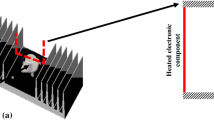Abstract
Passive (natural convection) and mixed-convection cooling of vertical stacks of heat-generating bodies located inside a cavity with openings for inlet and outlet coolant flow have been investigated numerically. The applicable equations for the conservation of mass, momentum, and energy were applied under laminar, steady-state two-dimensional flow conditions. The solution was obtained using a finite-control-volume approach. Results were obtained for three different stack geometries using different locations of the stack within the cavity and various locations of the inlet and outlet ports. It is demonstrated that passive cooling can be more effective than mixed-convection cooling for certain conditions and that the locations of the inlet and outlet ports relative to the stack position within the cavity have significant influences on the cooling effectiveness for all three geometries.














Similar content being viewed by others
Abbreviations
- a 1 to a 10 :
-
geometrical parameters
- C p :
-
specific heat, J/kg·K
- g :
-
gravitational acceleration, m/s2
- Gr :
-
Grashof number defined by Eq. 11c
- k :
-
thermal conductivity, W/m·K
- L :
-
dimension of cavity, m
- P :
-
dimensionless pressure defined by Eq. 11b
- p :
-
pressure, Pa
- p * :
-
dynamic pressure defined by Eq. 6, Pa
- Pr :
-
Prandtl number defined by Eq. 11c
- q′′:
-
heat flux at block walls, W/m2
- Re in :
-
inlet Reynolds number defined by Eq. 11c
- T :
-
temperature, K
- U :
-
dimensionless velocity component in the x direction defined by Eq. 11b
- u :
-
velocity component in the x direction, m/s
- V :
-
dimensionless velocity component in the y direction defined by Eq. 11b
- v :
-
velocity component in the y direction, m/s
- V in :
-
average inlet velocity of air, m/s
- x,y :
-
Cartesian coordinates, m
- X,Y :
-
dimensionless coordinates defined by Eq. 11a
- α:
-
ratio of the total mass flow rate through the channels formed by the blocks in the stack to the inlet mass flow rate
- β:
-
coefficient of thermal expansion, 1/K
- μ:
-
viscosity, N·s/m2
- θ:
-
dimensionless temperature defined by Eq. 11b
- ρ:
-
density, kg/m3
- ave:
-
average
- in:
-
inlet
- max:
-
maximum
- out:
-
outlet
References
Bejan A, Sciubba E (1992) The optimal spacing of parallel plates cooled by forced convection. Int J Heat Mass transfer 35:3259–3264
Bejan A, Kim SJ, Morega AM, Lee SW (1995) Cooling of stacks of plates shielded by porous screens. Int J Heat Fluid Flow 16:16–24
Fowler AJ, Ledezma GA, Bejan A (1997) Optimal geometric arrangement of staggered plates in forced convection. Int J Heat Mass transfer 40:1795–1805
Young TJ, Vafai K (1998) Convective flow and heat transfer in a channel containing multiple heated obstacles. Int J Heat Mass transfer 41:3279–3298
Young TJ, Vafai K (1999) Experimental and numerical investigation of forced convective characteristics of arrays of channel mounted obstacles. J Heat Transfer 121:34–42
Hung TC (2001) A conceptual design of thermal modeling for efficiently cooling an array of heated devices under low Reynolds numbers. Numer Heat Transfer Part A 39:361–382
Dooher BP, Mills AF (2000) Natural-convection thermosyphon heat transfer from a stack of horizontal plates. Exp Heat Transfer 13:125–136
Mufuta JM, Van den Bulck E (2001) Modelling of the mass flow distribution around an array of rectangular blocks in-line arranged and simulating the cross-section of a winding disc-type transformer. Appl Therm Eng 21:731–749
Shuja SZ, Yilbas BS, Budair MO (2000) Natural convection in a square cavity with a heat generating body—entropy consideration. Heat Mass Transfer 36:343–350
Shuja SZ, Iqbal MO, Yilbas BS (2001) Natural convection in a square cavity due to a protruding body—aspect ratio consideration. Heat Mass Transfer 37:361–369
Dubovsky V, Ziskind G, Weiss Y, Aharon J, Katz M, Letan R (2002) Passive cooling of cylindrical bodies in an enclosed space with openings. Proceedings of the 12th International Heat Transfer Conference, vol. 2, pp 717–722
Bilgen E, Yamane T (2004) Conjugate heat transfer in enclosures with openings for ventilation. Heat Mass Transfer 40:401–411
Patankar SV (1980) Numerical heat transfer and fluid flow. Hemisphere Publishing Corp, New York
Prakash C, Patankar SV (1985) A control-volume-based finite-element method for solving the Navier-Stokes equations using equal-order velocity-pressure interpolation. Numer Heat Transfer Part B 8:259–280
Schneider GE, Raw MJ (1987) Control-volume finite-element method for heat transfer and fluid flow using co-located variables—computational procedure. Numer Heat Transfer Part B 11:363–390
Ramirez-Iraheta OA (2004) Passive and mixed-convective cooling of vertical stacks of heat-generating bodies in a square cavity with openings. M.Sc. thesis, University of Manitoba, Canada
Acknowledgments
This research has been funded by grants from Manitoba Hydro and the Natural Sciences and Engineering Research Council of Canada. This funding is gratefully acknowledged.
Author information
Authors and Affiliations
Corresponding author
Rights and permissions
About this article
Cite this article
Ramirez-Iraheta, O.A., Soliman, H.M. & Ormiston, S.J. Effective cooling of vertical heat-generating stacks in a cavity with openings. Heat Mass Transfer 42, 398–410 (2006). https://doi.org/10.1007/s00231-005-0030-5
Received:
Accepted:
Published:
Issue Date:
DOI: https://doi.org/10.1007/s00231-005-0030-5



